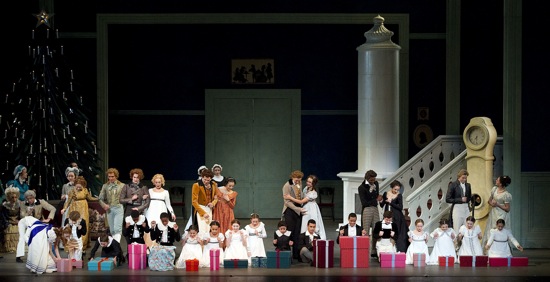
Opening presents in ABT’s production of Alexei Ratmansky’s The Nutcracker. Photo: Gene Schiavone
The Nutcracker in its many manifestations is like an attic toy box into which generations of children have tossed the playthings they’ve grown too old for. Amid the dolls and stuffed animals and fairy tales and toy soldiers are folded longings, nightmares, pre-pubescent thoughts of sex, and fear of growing up. The ballet by Lev Ivanov that premiered in St. Petersburg in December of 1892 has bourréed across centuries, discarding this, adding that. Mark Morris, for his delectable The Hard Nut, even leapfrogged backward over the ballet to introduce one of the more gruesome features of the E.T.A. Hoffmann tale, and one that was left out of The Nutcracker’s scenario. Not for the Tsar and his court a scene in which mice gnaw the nose off a royal baby.
The most enduring element, of course, is Tchaikovsky’s score; its cohesive power and its beauties bind even mediocre Nutcracker ballets together.
When you think about it, tatters of Freudian thinking have clung to Nutcracker productions from the outset. The very title character is suspect. What manner of kindly uncle gives a little girl a large, hard soldier doll? What sort of little girl takes it in her arms? It is said that in the original apotheosis, a gigantic golden hive swollen with honey appeared, surrounded by “flying bees fiercely guarding their treasure” (this account quoted by Anna Kisselgoff in a 1976 article). In Mikhail Baryshikov’s 1976 Nutcracker for American Ballet Theatre, the warring rodents were the dapper husbands and fathers of the Christmas party scene who’d acquired tails and mouse heads.
The marvelous Nutcracker by Alexei Ratmansky (performed by American Ballet Theatre at BAM’s Howard Gilman Opera House December 7 through 16) is a little more clearly the tale of a young girl’s dream, mixed up with characters and visions from her parents’ party, than is George Balanchine’s beautiful almost-sixty-year-old classic (showing at Lincoln Center through December 30). In Balanchine’s version, the Sugar Plum Fairy who welcomes the child heroine and her little live Nutcracker friend is a gracious hostess. The pas de deux that she dances with an anonymous cavalier is a lesson in poise and beauty that any child might aspire to. The two adult dancers could even be idealized images of little Marie’s parents, once out of their stuffy parlor, as well as herself and her lover-to-be.
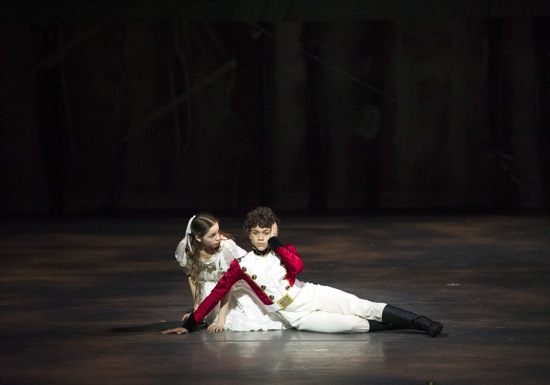
The Nutcracker comes to life. Victoria Arrera (Clara) and Kai Monroe. Photo: Gene Schiavone
Ratmansky adopts another point of view. His Sugar Plum Fair is played by the same dancer (Courtney Lavine) who has the role of the Stahlbaums’ nurse (the very one who, before the Act I party, covers the two children’s eyes so they won’t see their parents kiss). Dressed in astonishing pink-trimmed, lime-green finery (including a gigantic turban), she bustles about, and the climactic pas deux is performed by the dancers who’ve already appeared in another duet that links them firmly with little Clara (aka Marie) and her Nutcracker (the children swirl together in the snowy landscape; their young adult counterparts echo, then replace them). At the end of the main pas de deux, the dream prince proposes. And Ratmansky wants us to understand that everything that has occurred since the party ended is a dream. Young Clara lies on her bed. Waking, she sees the child prince on one side of the stage, the adult one on the other. She reaches to each; they recede into the wings. She lies back down, lifts the wooden nutcracker and gazes on it adoringly. No longer a child, not quite a woman.
She also has become a better person. Ratmansky, I suspect, knows kids well. His Clara is just as jealous and temperamental and grabby in the first act as her spoiled little brother. But once she has saved the brave Nutcracker doll from the mouse brigade by throwing a slipper down at the Mouse King from a grown-huge chair and distracting him, she’s on the road to recovery.
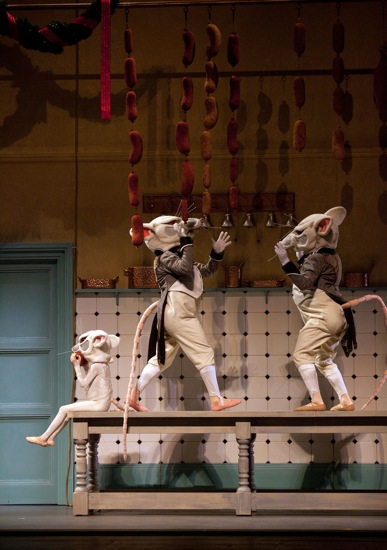
Two marauding mice in the Stahlbaum’s kitchen, plus a rascally mouseling. Photo: Rosalie O’Connor
That climax is one of the few in which the drama is unaccountably fudged. Ratmansky usually is a master of detail. The adorable, skinny little mouse (Justin Souriau-Levine), who keeps slipping and falling as he races about the Stahlbaum kitchen in the opening scene, is the first rodent to clamber out of the huge copper stewpot once the cook and maids have hustled the hors d’oeuvres out the door. The arthritic grandmother (Sarah Smith) is moved to show that she can still shake a leg, and all onstage applaud. When the guests have gone, one of the maids naughtily mimics a step from the old lady’s’s little exhibition, and the other maid shows how la-dida she thought the invitees were (Isadora Loyola and Luciana Voltolini play these two charmingly). This last little vignette takes about 10 seconds and says a lot.
How edible are the denizens of the place often known as the Kingdom of the Sweets? The association of Spanish dancers with chocolate, Arabian ones with coffee, and Chinese ones with tea is tenuous anyway. Ratmansky gives us a United Nations that appears to include Ireland (seven women are billed, somewhat puzzlingly, as the Nutcracker’s sisters, but their green and white outfits with top hats would fit into any St. Patrick’s Day parade). In addition to some piquant choreography, Ratmansky offers witty cultural critiques. The three Russians exert themselves in jumps and tumbles and group efforts; good-natured buffoonery yields virtuosity as if by accident. To fine comic effect, the four apparently devoted harem wives tire of their muscular master’s self-satisfied domination and unexpectedly turn on him (James Whiteside struts so outrageously you can’t believe they’ve waited so long to humble him).
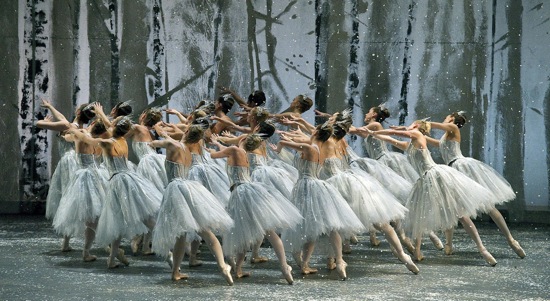
Beware children! Ratmansky’s Snowflakes create a blizzard. Photo: Gene Schiavone
Ratmansky’s choreography often moves interestingly between realism and abstraction. His 24 dancing Snowflakes begin as a gentle flurry and turn into a blizzard, but not just by swirling faster in denser patterns. This storm is dangerous to wandering children. The women in white turn malevolent—pulling Clara and the Nutcracker apart and making threatening gestures as if to blind them like any heavy snowfall. Jennifer Tipton’s lighting compounds the menace, and Drosselmeyer arrives in the nick of time to melt them. The 12 Flowers who dance to Tchaikovsky’s pretty waltz are attended by four athletic drones, and as the dancing builds, the women rush at them by turns and get tossed from one to the other. This veritable tempest of petals shines a new light on plant fertilization.
The dancing is often unusual; the prince gives a little extra flick of his leg where you weren’t expecting one, for instance, or partners change their grip in surprising ways. This choreographer wants to show us love budding and blooming. In the first duet by Clara (as Princess) and the Nutcracker Prince, the young lovers are slightly more tentative; they have to stop and look at each other adoringly now and then, before they swoop into something new and exciting. In the grand pas de deux, too, they cover a lot of space. Clara skims around in her solo as if she’s exultantly marking out the territory of love. Ratmansky subtly undermines the ways in which classical partnering often keeps the couple in one spot—the man manipulating the woman as she balances on one toe. In one of those “promenades” in arabesque, the prince keeps rotating his sweetheart—and revolving around her—in ways that make her flower rapidly into a multitude of new positions. This is what love can do to you.
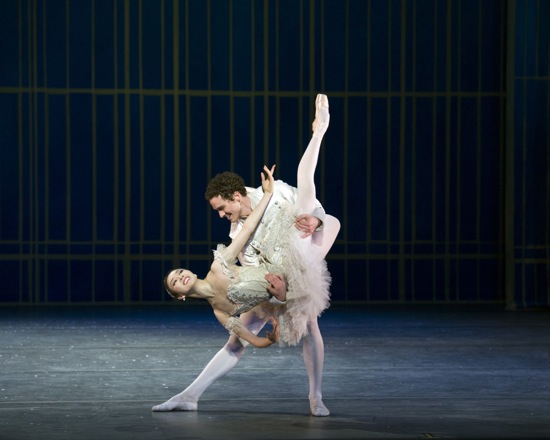
A dream wedding: Clara and her Prince (Hee Seo and Cory Stearns). Photo: Gene Schiavone
I saw only one cast—a splendid one. Hee Seo and Cory Stearns are marvelous together—smooth as silk and radiantly happy. They make the difficult, showy steps look like voyages of discovery. Even the expected lifts don’t have that click-the-camera-now attitude. Ratmansky must be a good director (and/or a fine crafter of roles). The performers act their parts with nuanced conviction—down to Gregor Mackenzie Gillen as Fritz, the bratty brother, and including those who appear only briefly, like Julio Bragado-Young as the exasperated cook in the opening scene. In this Nutcracker, the role of the young Clara isn’t an easy one; it requires a range of emotions, and Victoria Arrea delivers them all with splendid aplomb.
This Nutcracker is gorgeous to look at. Richard Hudson, who designed the set and costumes, has dressed the people who gather for the party in diverse fashions of the early 19th century, and the mice that infest their household wear military-style tailcoats. The magic life-sized dolls that Drosselmeyer (Roman Zhurbin) brings as party entertainment not only dance wonderfully; they wear perhaps the best costumes of the many stunning ones—intricately patterned black-and-white ones for Luciana Paris and Craig Salstein, vividly colored ones for Nicole Graniero and Mikahil Ilyin that recall Diaghilev’s designer Leon Bakst.
I love it that when the child-sized Nutcracker (well performed by Kai Monroe) is damaged by Clara and Fritz’s tussle, the other four toys run in and stand staring sadly down at him. A fallen comrade. It’s a strange moment, like the “backstage” scenes in Mikhail Fokine’s Petrushka; the magic dolls are shown to have emotions, and you wonder what’s real and who’s in control. Come to think of it, that question lies at the heart of The Nutcracker. Trust Ratmansky to remind us of it whenever he can.

An interesting review, giving much to think about. Freudian analysis of course abounds of Hoffmann’s tales, not to mention those by the brothers Grimm, and I’ve long felt acute distaste for Baryshnikov’s much too obviously Freudian interpretation of the Nutcracker, where Clara is almost literally pulled between Drosselmeier and the Nutcracker Prince. I saw Oregon Ballet Theatre perform Balanchine’s after I heard the hideous news of the murder of children in Connecticut; the happy children in the party scene made me weep, and made me feel a little better, at least for a while, reminding me of why we go to the theater in the first place. Thanks, Deborah.
Nutcracker often reminds me of fromage blanc, the plain white cheese that you can flavor however you like. The Pacific Northwest Ballet version has an Orientalist tilt to the second act (in part from Sendak’s truly lovely sets and costumes) which seems to have led to Stowell using the Drosselmeyer character as a Pasha running the show, rather than the usual Sugar Plum royalty. He comes across as a bit tyrannical and possessive — fortunately Clara is danced by an adult in this act, or there could be a nasty pedophile interpretation.
Somewhere there is a paper to be written about how different productions position the role of Clara/Masha/Marie – child vs adult.